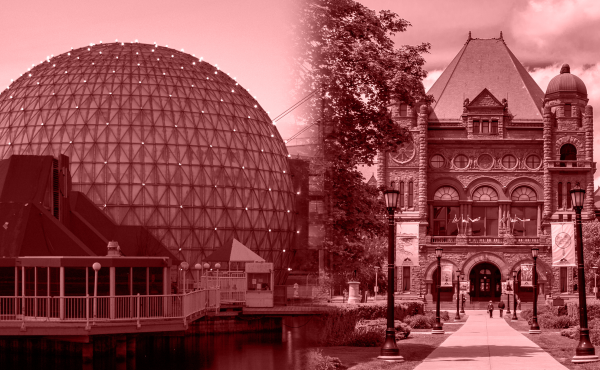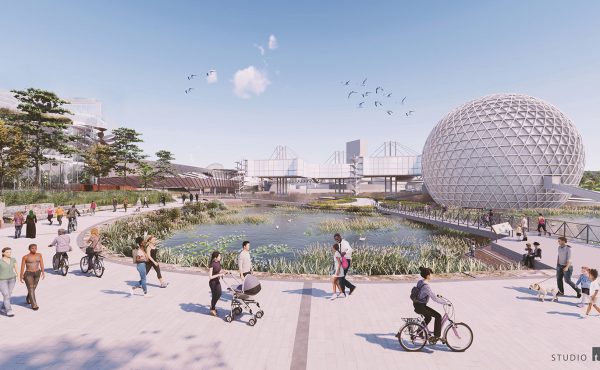
John Barber’s column (registered users or Google News search) in The Globe & Mail today discusses the increasing volume of a voice that has been shouting about the Island Airport for some time now: the Mississaugas of the New Credit. The Mississaugas have long disputed that the land now occupied by the Toronto Island Airport was never sold in either of the Toronto Land Purchases of 1787 and 1805. The islands were long considered a sacred place for the area’s native people.
[T]he continuing land dispute at Caledonia, a few kilometres away from the Mississaugas’ current home on part of the Six Nations Reserve near Brantford, has led to discussions among band members about bringing similar pressure to bear in Toronto, according to the source. At the same time, the New Credit group is recruiting allies among other Mississauga bands throughout Southern Ontario in order to help press the cause.
The Mississaugas have also released conceptual drawings of proposed redevelopments for the site, which “show a sprawling complex, complete with a hotel, museum and entertainment facilities, on land that is now the western half of the existing airport. Conceived as a centre of aboriginal culture in Toronto, the complex also includes an arena and parkland.”
The Mississaugas have made no mention of it one way or the other, but Barber is quick to point out that concerns about the development of a casino on the Island have been mentioned. Although it’s a very intricate issue, would Torontonians embrace this kind of development on the island if it meant the end of the Island Airport?
Image from Mississaugas of the New Credit First Nation




14 comments
I’d be curious to know when (or if) these claims have been made before about the islands. Was this ever brought up in the 60s or 70s or 80s???
I suppose this is a federal issue, which means that the feds will probably keep up Canada’s long tradition of not honouring treaties or land rights.
http://tinyurl.com/yly9cc
This is a good question. The claims were probably not raised until recently for a few reasons:
Aboriginal people were not recognized as “persons” and did not have the right to vote until 1958. Aboriginal people were also prohibited by law from hiring lawyers or raising funds for any legal claims against the Crown until the 1960s. So its not surprising that there has been a bit of a time lag. The preparations for a land claim can take many years (5-10) years and it can take anywhere from 10-40 years for a land claim to be negotiated. Furthermore, the federal governmnet only negotiates 4-5 land claims at a time. With 300+ unresolved land claims in Canada, well, you do the math.
(which is why an arms-length body established to deal with land claims issues would be such a great idea!)
Isn’t almost all the land forming the airport infill? I checked old maps and maybe a few fingers of Gibralter Point actually existed back when, but most of the airport land didn’t exist.
Does anyone know if the disputed land is only where the airport is or all of the islands? Would it affect the homes on Ward’s Island? Presumably since Algonquin has made from dredging material it wouldn’t cover them?
Kevin and Yolanda – have you seen the reports of the treaties recently agreed in BC?
There’s a surprising dearth of information readily available on the subject. It seems it’s only recently been gaining some steam in the mainstream press. I’ll have to do some digging because I share some of the questions posted here.
Bob: The land of the airport is mostly infill, which, in a way, would seem to be the least likely spot for a land claim. I suppose the fact that it is land south of the mainland (i.e. an area not specifically covered by either of the land purchases) is the basis for the claim. I’m not sure why the rest of the islands don’t form part of the claim (or if they do, why it’s never mentioned).
Kevin: You’re right – it is a federal issue, and that’s where the claim has been sitting for a while. That’s why the group has been considering “stepping up” their claim by demonstrating at the foot of Bathurst.
As a side note: Some time in the last 6 months (pre-Tasse report), I recall reading that Miller would like to see a museum for aboriginal culture go up on the site as part of a redevelopment of the lands. It seems he’s acknowledged the spirit of the land claim, which is about all he has the power to do.
i bet robert deluce can’t wait to sue them too. jackpot!
The question of land claims continues to fascinate. If you want to find out more details on the process and specific claims, check out the website of the Indian Claims Commission (http://www.indianclaims.ca). The commission’s mandate includes helping First Nations and the federal government to settle land claims and to provide an alternative to the lengthy and costly court cases – basically the ICC conducts an initial extensive review of the case to determine whether it falls within the mandate of the land claims process or whether it should be resolved otherwise. The claim reports are an interesting read on how our nation was created.
I am no authority, but I seem to recall seeing a series of maps that showed the transission of the Toronto shoreline since the settlement at York. I believe the shoreline was pushed out into the lake through dumping fill from developments. This caused a change in currents, and the sandbar in the lake emerged as an island. If my memory of these maps is correct, there would not have been an island for the First Nation to give up. I would expect the geographic record would be with the Ontario Ministry of Natural Resources’s map library, that existed in Whitney Block, Queens Park, in the ’80s when I worked there.
If the Mississaugas of the New Credit have a valid claim on Toronto Island, or any other part of the city, then they have rights in the matter, and the wishes of Toronto residents, or the city government, have no bearing on those rights. What we want, and particularly our desires for the airport, cannot dictate the Mississaugas’ exercise of their rights.
The question of what rights the Missisaugas can actually claim, particularly over the airport property, depends on the history and on the wording of the treaty. Since I do not currently have access to the Toronto, and I claim no expertise in the legal and archival disciplines involved, I have no comment on the legal validity of any particular position involving the treaty.
However, the Mississaugas of the New Credit have not merely made a claim; they have also told us what they want to do with the land and resources they claim. On that basis, we can address some questions about the resources that will best serve the stated goals of the Mississaugas of the New Credit, while at the same time providing an environmentally acceptable, affordable, and equitable solution.
In that light, I would ask if dedicating a part of the portlands or the Don Valley River Mouth to the proposed housing, cultural, and economic centre for Toronto’s urban First Nations communities would not work better than destroying the airport. I base this on four specific points:
1.The airport sits on fill dredged out of the harbour in the 1930s. The soil may contain some fairly high concentrations of heavy metals. That may well make building cultural venues or housing on the site very difficult and expensive.
2.A First Nations cultural centre on the port lands has the potential to anchor a positive development plan (something other than a cluster of big box stores) in the eastern waterfront. Such a cultural and housing development would also
3.Toronto City Centre still provides the best access to the major hospital complexes in Toronto. Many Northern communities have a vital interest in that access. If we destroy Toronto City Centre Airport, we will have to build another, less conveniently sited reliever airport to accommodate medical flights, at a cost the Greater Toronto Airport Authority estimates at $300 million.
4.Continuing the operation of Toronto City Centre Airport serves the principle of environmental equity.
http://torontoisland.org/CommunityAssociation/tabid/186/Default.aspx
Some excellent demographics on the community.
Homes are owned, taxes are paid, land is leased from the city, 99 year leases from 1993.
I thought I posted this, but it is not here. Hmmm…
The Indian Land Claims (ICC) site mentioned above, is interesting reading if you are wondering about this claim, called the Toronto Purchase.
After struggling through the documents, I came to the conclusion that the land claim itself is already completed: The government has been negotiating a settlement price for Toronto itself, and the Islands are unceded territory, to which the Mississaugas still have title.
It is not the same as Caledonia where title has yet to be acknowledged: The federal government has already acknowledged that Toronto Islands belong to the Mississaugas. They are proceeding carefully to reclaim them, and appear to be focusing on the airport.
It would be wonderful to have a major aboriginal culture centre in Toronto!